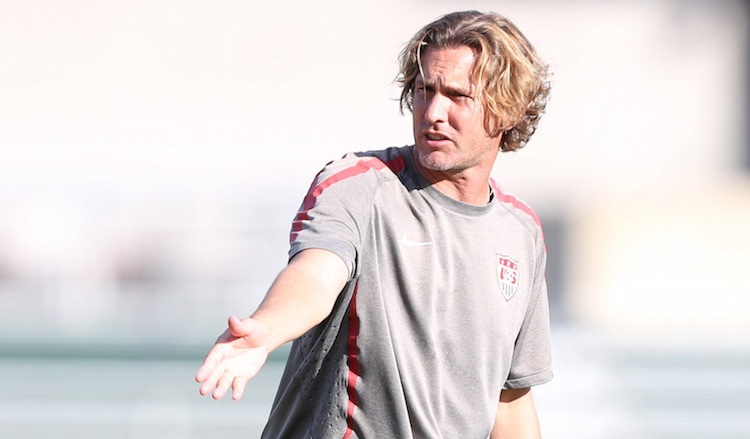Christian Lavers on Identifying And Watching A Developmental Saboteur in Youth Soccer
Christian Lavers is the President of the ECNL and is Exec VP of US Club Soccer. Lavers is also an Assistant Coach with the National Women’s Soccer League (NWSL) Chicago Red Stars and the Director of Coaching at FC Wisconsin Eclipse. His 16 years of coaching experience includes time with the U.S. Youth National Teams program.
Outspoken as always, here is a controversial indictment on what is happening in youth soccer today – as a bold act to protect today’s youth soccer players who deserve better player development from coaches.
“Truth is dangerous…”
“It topples palaces and kills kings. It stirs gentle men to rage … wakes old grievances and opens forgotten wounds. And yet there is one thing that is more dangerous than Truth. Those who would silence Truth’s voice are more destructive by far.” — Frances Hardinge

Speaking truth can be difficult, especially when doing so challenges long-held opinions or forces a re-examination of fundamental beliefs.
Seeking, finding and embracing truth, however, is the only path to improvement. Youth soccer is filled with truths about player development – articles about coaching methods, curriculums for creating training sessions, presentations to watch training activities, and more.
 The prevalence and distribution of these articles, courses, videos, and presentations, has done much good – no coach in their right mind any longer questions that teaching technique at young ages is important, that passing is a skill while “kicking” is not, and that results should not be emphasized at young ages. These are truths that are easy to tell – they are culturally accepted and are so vague and general as to be impossible to argue against.
The prevalence and distribution of these articles, courses, videos, and presentations, has done much good – no coach in their right mind any longer questions that teaching technique at young ages is important, that passing is a skill while “kicking” is not, and that results should not be emphasized at young ages. These are truths that are easy to tell – they are culturally accepted and are so vague and general as to be impossible to argue against.
Impactful truth, in contrast, is often not easy to tell and not easy to hear. It challenges people, scares people, and sometimes offends people. It forces re-assessment and re-thinking, it stimulates change, it challenges the status quo. Here is one such truth in youth soccer:

Many coaches, and much of the coaching that occurs in many of the youth soccer clubs in this country is done in total opposition to the accepted truths of player development.
This is a harsh statement to make, and for parents and coaches in youth soccer, it can be even harder to hear. Still, the fact remains that many coaches, at the most important youth age groups, don’t actually teach soccer technique or tactics, and don’t progressively challenge players with new concepts and new technical challenges as they grow.
Even fewer understand how to teach a young player to apply a technique, and how to look at the game and actually SEE THE GAME – where to pass, how to find space, where and why to run, and why to make this choice or that.
In reality, the “truths” that are now commonly accepted about “what player development looks like,” have failed to change the way many coaches train players and how many parents view youth soccer.
Coaches put on sessions that “look right” but in actuality have little specific teaching or tactical application, and parents are confused as to how to identify whether their children are actually learning and improving – or whether they are just spending time on the field. There are two reasons for this disconnect: (i) a lack of understanding (or misunderstanding) of the differences between real development and pseudo-development; or (ii) a lack of desire to truly develop or be developed.
While the latter problem is a motivation problem that can’t be externally fixed, the former problem can be – by more clearly speaking truth to eliminate grey area and misconceptions.
In other words, the solution to correcting misunderstanding is to tell the truth with clearer words, in a blunt, impossible to misunderstand, and potentially hard-to-hear way.
The type of coach described above, the type that does not actually teach the game but instead practices pseudo-development, is a developmental saboteur. And while the term “saboteur” may be exotic or exaggerated, the negative impact of this type of coach on the long-term potential of his or her players is not. Below is an example of how the developmental saboteur operates in the soccer world:
Developmental saboteurs look the part and act the part, and they certainly talk the part. They wear the newest tracksuit, they drop catchy buzzwords, and they advocate a “style like Barcelona” (or whoever the latest, greatest team in the world may be).
In club soccer, developmental saboteurs usually coach primarily at the U10-U14 age groups.
They pick these age groups carefully for two reasons.
First, they involve parents and players that are frequently new to the game, and therefore uneducated about the soccer world.
Second, these age groups are “sweet spots” for winning without teaching. At this age, the recipe for competitive success is relatively simple for anyone with basic soccer knowledge and poor motives: recruit 1-2 technically or physically advanced players, put them up front, be marginally organized, and play low-risk soccer (code for “kick the ball forward”) everywhere else.
Developmental saboteurs use one or two players as their weapons and tools. They identify the best players at a young age (9-13 usually), those players who are already either physically advanced or technically advanced, (neither of which occurred with any aid from the coach), and then begin to become exceptionally close to their parents.
 Developmental saboteurs sell visions of grandeur – making promises of incredibly bright futures, comparing this year’s great player to the greatest player they have ever coached, and more. They tie this vision to their own exclusive ability to bring the chosen player to the Olympic podium. Developmental saboteurs exaggerate (or outright falsify) their connection to the pros, the national teams, or the biggest colleges – with promises of unique connections and abilities to open exclusive doors purely by their own word of mouth.
Developmental saboteurs sell visions of grandeur – making promises of incredibly bright futures, comparing this year’s great player to the greatest player they have ever coached, and more. They tie this vision to their own exclusive ability to bring the chosen player to the Olympic podium. Developmental saboteurs exaggerate (or outright falsify) their connection to the pros, the national teams, or the biggest colleges – with promises of unique connections and abilities to open exclusive doors purely by their own word of mouth.
Having succeeded at identifying the most advanced player(s) and recruiting these player(s) to their teams, the developmental saboteur then proceeds to win most games at these young ages by “playing at soccer” – using competitive results to bolster their aforementioned claims.
Finally, in his or her most intelligent move yet, the developmental saboteur disappears around U15 or U16 to move on to the next young generation of players. Having already done their damage, the developmental saboteurs disappear just before their impact (destruction of long-term potential) begins to be seen – when the former star player(s) are no longer so dominant, and the lack of development of these stars or any of the other players begins to be seen on the scoreboard.
Through misunderstandings in the community of the truths of what development actually looks like, developmental saboteurs are often regarded as “good coaches,” even as they quietly and competently destroy the long-term potential of their players.
They create a fake developmental environment with competitive success and little teaching, little learning, and little progress. The talents of their top recruits are carefully milked for short-term wins as the “coach” gets as much as possible from the advanced ability levels of the top players while rarely raising any player’s ability level an inch.
Developmental saboteurs use the game for their own benefit and destroy the potential of the game to benefit their players. They do this by selling promises they can’t keep, and misleading parents and players with ambiguities laced with buzzwords. They are successful just long enough in on generation in order to move on to the next one with their artificial track-record of success.
Correcting the misunderstandings requires recognizing the developmental saboteurs.
It isn’t difficult if you know what to look for, and more importantly, if you care enough about the long-term potential of young players to look carefully. Developmental saboteurs:
Talk well about the game but in meaningless generalities.
Their words are right, but the context is wrong, the purpose absent.
By mixing soccer terminology with long-winded soliloquies they convince people of their own intelligence by confusing them or boring them.
Are full of exaggerated compliments and huge promises, creating “special connections” that are used to put a damper on the doubts and uncertainties that players and parents begin to feel over time.
Constantly throw out the names of players from years past (more and more distant over time) that “they developed” as proof of their ability. Often, current top players are told of how they could be the next “special player” – or even that they are already better than that “special player” was at the same age. (On a side note: beware of any coach claiming to be the “special coach” who developed a “special player.” Players develop primarily based on their own abilities and desires; if you want to know who the “special players” credit for helping them – ask them.)
Use buzzwords on the sideline of games that sound good and developmentally focused, but their players show little understanding of what these terms mean or lack any idea about how to do what they are asked. This is a clear indication that they have never been taught anything that they are now being yelled at to do. Phrases like “pass the ball” and “keep the ball” that are thrown out to players with no passing technique, or players that have no idea where to look to pass the ball, are attempts to sound good to the sidelines while hiding the fact that there has been no development in the individual.
Have teams totally dominant on 1-2 players who are technically or athletically gifted, and are surrounded by other players that also happen to be on the field for the sole purpose of giving the ball to these “next special player(s).” The “also on the field” players usually can’t do much right except give the ball to the “next special player(s)” – and most mistakes are their fault
Have a litany of reasons for any loss, most of which are focused on outside factors – especially the referee. They use these excuses in an attempt to draw attention away from the real reasons for these losses – lack of development. These excuses become much more frequent over time – as earlier doormat opponents become more and more competitive, and previous big wins become close wins and eventually losses.
Isolate their top player(s) from outside influences and information – keeping them away from other coaches, other environments, and other influences. This protects the naivety of these players and their parents – without other different information they are left with only one source of information, the wrong one.

Create in their young teams a fear of separation, a feeling that they must stay together because of their incredibly unique bond, or their special potential. These feelings are also used to isolate players and parents from conflicting information and different experiences so that they don’t even consider looking outside of this fake Shangri-La.
If your son or daughter is playing in one of these environments, recognize what is happening.
Their potential is being lost at the ages where it is most important that they learn the most. Their long-term futures are being destroyed for the short-term goals of the development saboteur.
RELATED ARTICLES: YOUTH SOCCER COACHES MUST HAVE THE COURAGE TO BE PATIENT, ALPHABET SOUP OF YOUTH SOCCER – ECNL PRIMER





